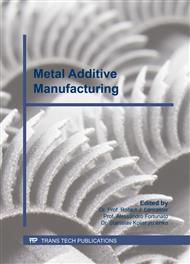p.961
p.967
p.976
p.982
p.988
p.995
p.1004
p.1010
p.1016
Experimental Investigation of Temperature Distribution during Wire-Based Laser Metal Deposition of the Al-Mg Alloy 5087
Abstract:
Wire-based laser metal deposition enables to manufacture large-scale components with deposition rates significant higher compared to powder-based laser additive manufacturing techniques, which are currently working with deposition rates of only a few hundred gram per hour. However, the wire-based approach requires a significant amount of laser power in the range of several kilowatts instead of only a few hundred watts for powder-based processes. This excessive heat input during laser metal deposition can lead to process instabilities such as a non-uniform material deposition and to a limited processability, respectively. Although, numerous possibilities to monitor temperature evolution during processing exist, there is still a lack of knowledge regarding the relationship between temperature and geometric shape of the deposited structure. Due to changing cooling conditions with increasing distance to the substrate material, producing a wall-like structure results in varying heights of the individual tracks. This presents challenges for the deposition of high wall-like structures and limits the use of constant process parameters. In the present study, the temperature evolution during laser metal deposition of AA5087 using constant process parameters is investigated and a scheme for process parameter adaptions in order to reduce residual stress induced componential distortions is suggested.
Info:
Periodical:
Pages:
988-994
Citation:
Online since:
December 2018
Price:
Сopyright:
© 2018 Trans Tech Publications Ltd. All Rights Reserved
Share:
Citation:



